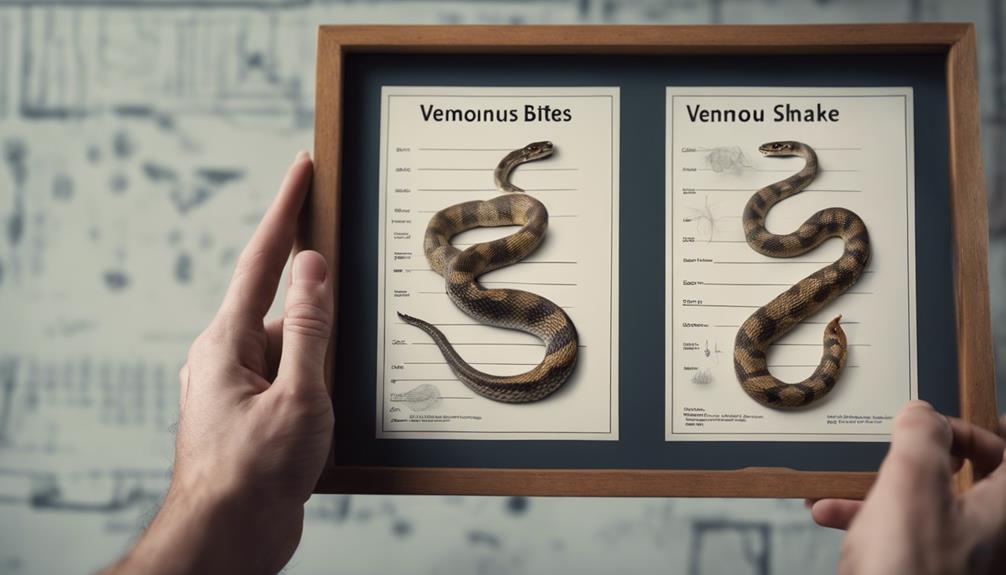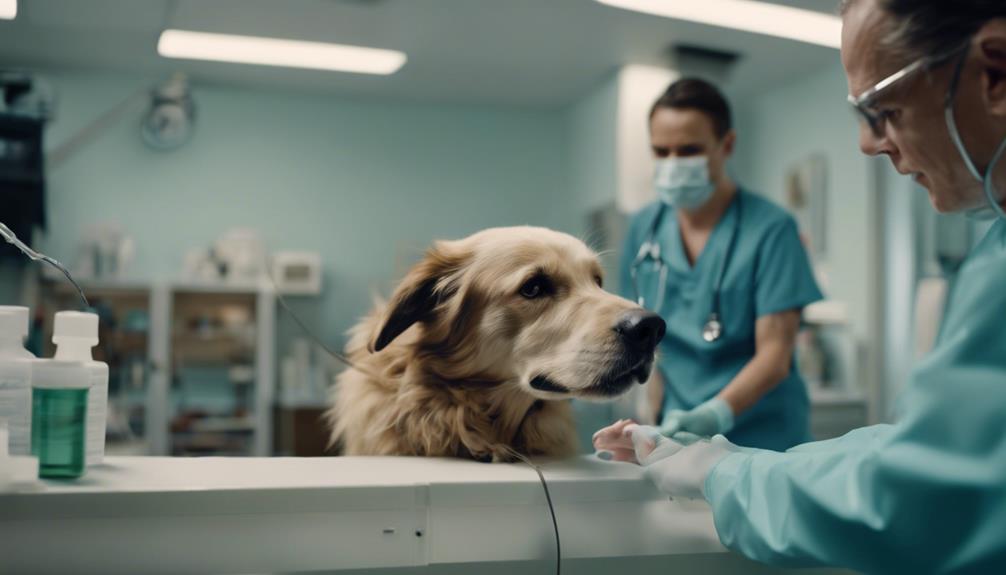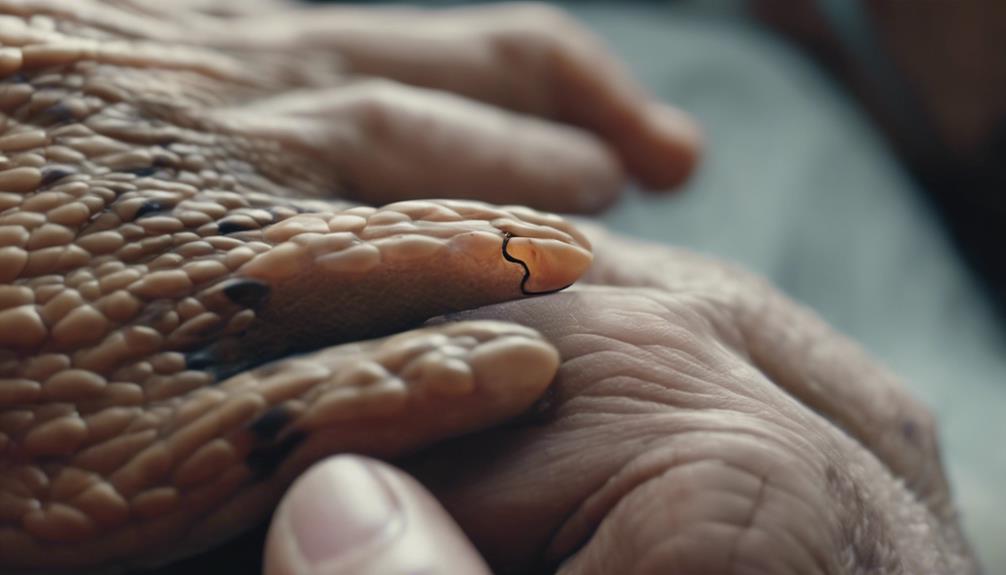When a snake bites a dog, prompt action is essential in ensuring the animal's safety and well-being. Understanding the signs of a snakebite and knowing how to administer immediate care can make a significant difference in the outcome of such a situation.
By being prepared and knowledgeable about the necessary steps to take, pet owners can potentially save their dog's life.
Stay tuned to discover the crucial information needed to handle a snakebite incident with composure and effectiveness.
Key Takeaways
- Recognize snakebite symptoms like swelling and weakness
- Provide immediate first aid by contacting vet and keeping wound below heart level
- Seek emergency treatment for venomous bites promptly
- Follow post-bite recovery guidelines and prevent future incidents with proactive measures
Recognizing Snakebite Symptoms
Recognizing the symptoms of a snakebite in dogs is crucial for prompt and effective intervention to ensure the well-being of your pet. Common symptoms include visible snakebite marks, swelling, bruising, weakness, aggression, and bleeding at the bite site. Dogs may also exhibit signs of pain, such as whining or limping, and in severe cases, they may experience difficulty breathing or show neurological symptoms like tremors or seizures.
It is important to observe your dog closely for these indicators, especially if they have been in areas where snakes are prevalent. Early recognition of these symptoms can expedite the necessary treatment and improve the outcome for your pet. Always seek veterinary assistance promptly if you suspect your dog has been bitten by a snake.
Immediate First Aid Steps
Upon encountering a snakebite on your dog, taking immediate first aid steps is crucial to mitigate potential complications and ensure the best possible outcome for your pet.
The initial response should be to contact your veterinarian or emergency animal hospital for guidance. While waiting for professional help, it is important to keep the bitten area below the level of the heart to slow the spread of venom. Avoid applying ice, tourniquets, or attempting to suck out the venom, as these can do more harm than good.
If necessary, gently rinse the wound with water to prevent infection. Monitor your dog closely for any changes in behavior or symptoms, and be prepared to provide CPR if needed.
Identifying Venomous Vs. Non-Venomous Bites

When differentiating between venomous and non-venomous snake bites on a dog, it is crucial to observe specific indicators to determine the appropriate course of action for treatment. Here are some key differences to help identify the type of snake bite:
| Indicator | Venomous Bite | Non-Venomous Bite |
|---|---|---|
| Bite Marks | Often two puncture wounds close together | Multiple small puncture wounds |
| Swelling | Rapid and extensive around the bite area | Minimal swelling and localized |
| Symptoms | Severe pain, drooling, paralysis, vomiting | Mild pain, slight redness, no systemic signs |
Emergency Treatment for Venomous Bites
In cases of venomous snake bites on dogs, prompt and appropriate emergency treatment is crucial to mitigate the potentially life-threatening effects of the venom. Immediate steps include safely restraining the dog to prevent further agitation, keeping the affected limb below heart level to slow venom spread, and transporting the dog to a veterinary facility as quickly as possible.
It is essential to avoid applying ice, tourniquets, or attempting to suck out the venom, as these measures can worsen the situation. At the veterinary clinic, treatment may involve the administration of antivenom specific to the snake species, pain management, antibiotics to prevent infection, and supportive care such as fluid therapy.
Time is of the essence in these situations, and seeking professional help promptly can significantly improve the dog's chances of recovery.
Managing Shock and Fluid Therapy

Utilizing appropriate shock management techniques and implementing fluid therapy are critical components in the comprehensive treatment protocol for dogs suffering from venomous snakebites. Shock can be a severe complication following a snakebite, necessitating prompt intervention to stabilize the dog's condition. Fluid therapy plays a crucial role in supporting circulation, maintaining blood pressure, and aiding in the elimination of toxins from the body.
To effectively manage shock and administer fluid therapy:
- Monitor vital signs closely
- Calculate fluid rates based on the dog's weight and clinical status
- Use isotonic crystalloids for initial resuscitation
- Adjust fluid therapy based on the dog's response and ongoing monitoring
Implementing these strategies promptly can significantly improve the dog's prognosis and aid in their recovery.
Post-Bite Recovery Guidelines
Following the critical management of shock and fluid therapy in dogs bitten by venomous snakes, the focus shifts to implementing essential post-bite recovery guidelines to facilitate the dog's healing process and overall well-being.
During the recovery phase, it is crucial to ensure that the dog receives adequate rest in a quiet and comfortable environment. Encouraging the intake of water and providing a balanced diet can aid in promoting healing and restoring strength. Additionally, closely monitoring the wound site for any signs of infection, such as increased swelling, redness, or discharge, is essential.
Any unusual symptoms or complications should be promptly reported to the veterinarian for further evaluation and treatment. By following these post-bite recovery guidelines diligently, the dog's recovery process can be supported effectively.
Monitoring Wound and Complications

A crucial aspect in the recovery process after a dog has been bitten by a snake is the vigilant monitoring of the wound and any potential complications that may arise. It is essential to keep a close eye on the dog's condition to ensure a smooth recovery.
Some key points to consider during the monitoring process include:
- Regularly inspecting the wound for signs of infection
- Watching for any unusual swelling or discoloration around the bite area
- Monitoring the dog's behavior for any changes in appetite, energy levels, or mobility
- Seeking immediate veterinary attention if any concerning symptoms or complications develop
Gastrointestinal Issues and Care
Addressing gastrointestinal issues in dogs following a snakebite is crucial for ensuring a comprehensive recovery plan. Snake venom can sometimes lead to gastrointestinal complications such as nausea, vomiting, diarrhea, or abdominal pain in affected dogs. These issues can further challenge the recovery process and may require specific care.
Veterinarians may recommend providing dogs with antacids to help manage any gastrointestinal distress resulting from the snakebite. Monitoring the dog's food intake and ensuring they stay hydrated are also essential steps in caring for their gastrointestinal health post-snakebite.
Prompt veterinary attention and following their guidance on managing gastrointestinal issues can aid in the dog's overall recovery and well-being.
Preventing Future Snakebite Incidents

To minimize the risk of snakebite incidents in dogs, proactive measures should be taken to create a safer environment for your pet.
- Keep lawn mowed and free of tall grass
- Remove potential hiding spots like woodpiles or debris
- Utilize rocks or mulch instead of dense shrubbery
- Secure trash cans and other food sources to deter snakes
Additional Resources for Pet Health
For further guidance on maintaining your pet's health and well-being, explore the array of resources available for pet owners. These resources encompass a wide range of topics related to pet health, including preventive care, common illnesses, emergency preparedness, and general wellness.
Online platforms such as veterinary websites, pet health forums, and educational blogs offer valuable insights into pet care practices and the latest developments in veterinary medicine. Additionally, consulting with local veterinarians, animal behaviorists, and pet trainers can provide personalized recommendations tailored to your pet's specific needs.
Pet health insurance companies and animal welfare organizations also offer resources on pet health management, nutrition, and overall well-being. By leveraging these resources, pet owners can enhance their knowledge and ensure the best possible care for their furry companions.
Essential Tips for Snakebite Preparedness

Be proactive in safeguarding your dog's well-being by implementing essential strategies for snakebite preparedness.
- Learn about snakes in your area and their habits
- Train your dog to avoid snakes through scent training
- Carry a snakebite kit during outdoor activities
- Keep your yard clear of debris and potential snake hiding spots
Conclusion
In conclusion, recognizing snakebite symptoms in dogs and administering immediate first aid is crucial for their well-being.
Understanding the difference between venomous and non-venomous bites, as well as implementing emergency treatments and post-bite care, can greatly impact the outcome of such incidents.
By prioritizing prevention strategies and being prepared for snake encounters, pet owners can effectively protect their dogs from potential harm and ensure their safety in the event of a snakebite.




